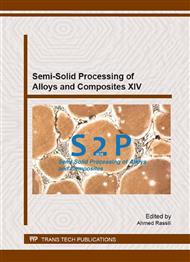p.94
p.100
p.107
p.113
p.119
p.126
p.133
p.139
p.146
Numerical Simulation of Thixo-co-Extrusion of 7075/AZ91D Double-Layer Tubes
Abstract:
Due to the excellent thermal conductivity and high strength of aluminum alloy and unique advantages containing shock absorbing, vibrations dampening and corrosion resistant of magnesium alloy, Al/Mg double-layer tubes have been widely utilized in household appliances, automobiles, aerospace industries, and high-speed trains in recent years. Conventionally, double-layer tubes are produced by welding, extrusion, hydroforming, magnetic pulse cladding. These processes are either complex or highly energy-consuming. To improve efficiency and reduce energy consumption, a new technology, thixo-co-extrusion (TCE), is put forward for production of double-layer tubes. In this paper, the thixo-co-extrusion of a 7075/AZ91D double-layer tube is investigated by numerical simulation. This study assesses the influences of extrusion velocity, the thickness ratios of two layers, the reheating temperatures of billets and the preheating temperature of die on the flow behaviors. The results show that the extrusion velocity and the thickness ratios significantly influence the contact pressures on the interface as well as the velocity fields. Besides, the reheating temperatures of billets and the preheating temperatures determine the distribution of temperature fields. Under the contact pressures and a certain temperature, atomic diffusion takes place on the interface between inner and outer layer, which leads to metallurgical bonding of the interface. The paper contributes to a better understanding of the thixo-co-extrusion technology for the production of double-layer tubes with desirable mechanical properties.
Info:
Periodical:
Pages:
119-125
Citation:
Online since:
September 2016
Authors:
Price:
Сopyright:
© 2016 Trans Tech Publications Ltd. All Rights Reserved
Share:
Citation:


